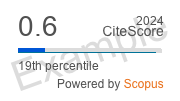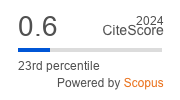The value of fibroblast growth factor 21 in health and pathology
https://doi.org/10.29001/2073-8552-2025-40-3-28-35
Abstract
The article presents current ideas about the role of fibroblast growth factor 21 (FGF21) in the regulation of carbohydrate and lipid metabolism, as well as its contribution to the development of systemic inflammation in rheumatoid arthritis, both in laboratory animals and in humans. The classification of the fibroblast growth factor family, regulation of expression and receptor apparatus is considered. Positive effects of FGF21 have been noted in the form of normalization of carbohydrate and lipid metabolism, body weight; drugs analogues of FGF21 have proven themselves well as a therapeutic agent for the treatment of metabolic complications such as diabetes and fatty liver disease. At the same time, data are provided on the connection between elevated levels of FGF21 in blood serum and a number of pathological conditions, such as type 2 diabetes mellitus, coronary heart disease, obesity, non-alcoholic fatty liver disease, and end-stage renal failure. The facts about the controversial role of FGF21 against the background of systemic inflammation in patients with rheumatoid arthritis (RA) are reviewed. On the one hand, FGF21 may have a protective effect in patients with RA; on the other hand, serum FGF21 can be considered as a predictor of future decline in functional status and a potential marker for the progression of systemic inflammation in patients with RA. The prospects for using FGF21 for therapeutic purposes are assessed.
About the Authors
Yu. R. AkhverdyanRussian Federation
Yury R. Akhverdyan, Cand. Sci. (Med.), Senior Research Scientist, Laboratory of Methods for the Treatment and Prevention of Joint Diseases, A.B. Zborovsky RICER; Associate Professor, Department of Clinical Laboratory Diagnostics, VolgSMU.
76, Zemlyatchky str., Volgograd, 400138; 2, 1, Pavshikh Bortsov squ., Volgograd, 400131
E. V. Papichev
Russian Federation
Evgeny V. Papichev - Cand. Sci. (Med.), Research Scientist, A.B. Zborovsky RICER; Associate Professor, Department of Clinical Laboratory Diagnostics, VolgSMU.
76, Zemlyatchky str., Volgograd, 400138; 2, 1, Pavshikh Bortsov squ., Volgograd, 400131
B. V. Zavodovsky
Russian Federation
Boris V. Zavodovsky - Dr. Sci. (Med.), Professor, Head of Laboratory of Methods for the Treatment and Prevention of Joint Diseases, A.B. Zborovsky RICER, Head of the Department of Clinical Laboratory Diagnostics, VolgSMU.
76, Zemlyatchky str., Volgograd, 400138; 2, 1, Pavshikh Bortsov squ., Volgograd, 400131
Yu. V. Polyakova
Russian Federation
Julia V. Polyakova - Cand. Sci. (Med.), Research Scientist, A.B. Zborovsky RICER.
76, Zemlyatchky str., Volgograd, 400138
L. E. Seewordova
Russian Federation
Larisa E. Seewordova - Cand. Sci. (Med.), Leading Research Scientist, A.B. Zborovsky RICER.
76, Zemlyatchky str., Volgograd, 400138
E. S. Rozhkova
Russian Federation
Ekaterina S. Rozhkova - Assistant, Department of Clinical Laboratory Diagnostics, VolgSMU.
2, 1, Pavshikh Bortsov squ., Volgograd, 400131
References
1. Rai M., Demontis F. Systemic nutrient and stress signaling via myokines and myometabolites. Annu. Rev. Physiol. 2016;78:85–107. https://doi.org/10.1146/annurev-physiol-021115-105305.
2. Whitham M., Febbraio M.A. The ever-expanding myokinome: discovery challenges and therapeutic implications. Nat. Rev. Drug Discov. 2016;15:719–729. https://doi.org/10.1038/nrd.2016.153.
3. Ornitz D.M., Itoh N. Fibroblast growth factors. Genome Biol. 2001;2(3):reviews3005. https://doi.org/10.1186/gb-2001-2-3reviews3005.
4. Bon Durant L.D., Potthoff M.J. Fibroblast growth factor 21: A versatile regulator of metabolic homeostasis. Annu. Rev. Nutr. 2018;38:173–196. https://doi.org/10.1146/annurev-nutr-071816-064800.
5. Suntsova M.V., Buzdin A.A. Differences between human and chimpanzee genomes and their implications in gene expression, protein functions and biochemical properties of the two species. BMC Genomics. 2020;21(7):535. https://doi.org/10.1186/s12864-020-06962-8.
6. Kim S.H., Kim K.H., Kim H.-K., Kim M.-J., Back S.H., Konishi M. et al. Fibroblast growth factor 21 participates in adaptation to endoplasmic reticulum stress and attenuates obesity-induced hepatic metabolic stress. Diabetologia. 2015;58:809–818. https://doi.org/10.1007/s00125014-3475-6.
7. Hirai Nomura K., Ikai R., Nakashima K.-I., Inoue M. Baicalein stimulates fibroblast growth factor 21 expression by up-regulating retinoic acid receptor-related orphan receptor α in C2C12 myotubes. Biomed. Pharmacother. 2019;109:503–510. https://doi.org/10.1016/j.biopha.2018.10.154.
8. Sugden M.C., Caton P.W., Holness M.J., Miller J.J. Receptors peroxisome proliferator-activated receptors. In: Jez J. (ed.) Encyclopedia of biological chemistry: 3rd edition. Elsevier, 2021:229–235.
9. Ogawa Y., Kurosu H., Yamamoto M., Nandi A., Rosenblatt K.P., Goetz R. et al. BetaKlotho is required for metabolic activity of fibroblast growth factor 21. Proc. Natl. Acad. Sci. USA. 2007;104(18):7432–7437. https://doi.org/10.1073/pnas.0701600104.
10. Agrawal A., Parlee S., Perez-Tilve D., Li P., Pan J., Mroz P.A. et al. Molecular elements in FGF19 and FGF21 defining KLB/FGFR activity and specificity. Mol. Metab. 2018;13:45–55. https://doi.org/10.1016/j.molmet.2018.05.003.
11. Ding X., Boney-Montoya J., Owen B.M., Bookout A.L., Coate K.C. et al. Beta Klotho is required for fibroblast growth factor 21 effects on growth and metabolism. Cell Metab. 2012;16:387–393.
12. Krol E., Grant L., Shearer K., Wyse C., Moncur E. et al. Methionine restriction restores a younger metabolic phenotype in adult mice with alterations in fibroblast growth factor 21. Aging Cell. 2014;13(5):817–827. https://doi.org/10.1111/acel.12238.
13. Fazeli P.K., Lun M., Kim S.M., Bredella M.A., Wright S., Zhang Y. et al. FGF21 and the late adaptive response to starvation in humans. J. Clin. Invest. 2015;125:4601–4611. https://doi.org/10.1172/JCI83349.
14. Patel R., Bookout A.L., Magomedova L., Owen B.M., Consiglio G.P., Shimizu M. et al. Glucocorticoids regulate the metabolic hormone FGF21 in a feed-forward loop. Mol. Endocrinol. 2015;29:213–223. https://doi.org/10.1210/me.2014-1259.
15. Veniant M.M., Hale C., Helmering J., Chen M.M., Stanislaus S., Busby J. et al. FGF21 promotes metabolic homeostasis via white adipose and leptin in mice. PLoS One. 2012;7(7): e40164. https://doi.org/10.1371/journal.pone.0040164.
16. Fisher F.M., Maratos-Flier E. Understanding the physiology of FGF21. Annu. Rev. Physiol. 2016;78:223–241. https://doi.org/10.1146/annurevphysiol-021115-105339.
17. Tezze C., Romanello V., Sandri M. FGF21 as modulator of metabolism in health and disease. Front. Physiol. 2019;10:419. https://doi.org/10.3389/fphys.2019.00419.
18. Kharitonenkov A., Shiyanova T.L., Koester A., Ford A.M., Micanovic R., Galbreath E.J. et al. FGF-21 as a novel metabolic regulator. J. Clin. Invest. 2005;115:1627–1635. https://doi.org/10.1172/JCI23606.
19. Inagaki T., Lin V.Y., Goetz R., Mohammadi M., Mangelsdorf D.J., Kliewer S.A. Inhibition of growth hormone signaling by the fastinginduced hormone FGF21. Cell Metab. 2008;8:77–83. https://doi.org/10.1016/j.cmet.2008.05.006.
20. Johnson C.L., Weston J.Y., Chadi S.A., Fazio E.N., Huff M.W., Kharitonenkov A. et al. Fibroblast growth factor 21 reduces the severity of cerulein-induced pancreatitis in mice. Gastroenterology. 2009;137(5):1795–1804. https://doi.org/10.1053/j.gastro.2009.07.064.
21. Jimenez V., Jambrina C., Casana E., Sacristan V., Muñoz S., Darriba S. et al. FGF21 gene therapy as treatment for obesity and insulin resistance. EMBO Mol. Med. 2018;10(8):e8791. https://doi.org/10.15252/emmm.201708791.
22. Shi Lu W., Hou Y., Fu K., Gan F., Liu J. Fibroblast growth factor ameliorates vascular calcification by inhibiting osteogenic transition in vitamin D3 plus nicotine-treated rats. Biochem. Biophys. Res. Commun. 2018;495(4):2448–2455. https://doi.org/10.1016/j.bbrc.2017.10.115.
23. Staiger H., Keuper M., Berti L., Hrabe de Angelis M., Häring H.-U. Fibroblast growth factor 21-metabolic role in mice and men. Endocr. Rev. 2017;38(5):468–488. https://doi.org/10.1210/er.2017-00016.
24. Partsernyak A.S. Fibroblast growth factor 21 and its influence on metabolic processes in the human body. Vestnik of Saint Petersburg University. 2018;13(1):38–45. https://doi.org/10.21638/11701/spbu11.2018.104.
25. Chavez A.O., Molina-Carrion M., Abdul-Ghani M.A., Folli F., DeFronzo R.A., Tripathy D. Circulating fibroblast growth factor-21 is elevated in impaired glucose tolerance and type 2 diabetes and correlates with muscle and hepatic insulin resistance. Diabetes Care. 2009;32:1542–1546. https://doi.org/10.2337/dc09-0684.
26. Zhang X., Yeung D.C.Y., Karpisek M., Stejskal D., Zhou Z.-G., Liu F. et al. Serum FGF21 levels are increased in obesity and are independently associated with the metabolic syndrome in humans. Diabetes. 2008;57(5):1246–1253. https://doi.org/10.2337/db07-1476.
27. Tezze C., Romanello V., Desbats M.A., Fadini G.P., Albiero M., Favaro G. et al. Age-associated loss of opa1 in muscle impacts muscle mass, metabolic homeostasis, systemic inflammation, and epithelial senescence. Cell Metab. 2017;25(6):1374.e6–1389.e6. https://doi.org/10.1016/j.cmet.2017.04.021.
28. Kohara M., Masuda T., Shiizaki K., Akimoto T., Watanabe Y., Honma S. et al. Association between circulating fibroblast growth factor 21 and mortality in end-stage renal disease. PLoS One. 2017;12:e0178971. https://doi.org/10.1371/journal.pone.0178971.
29. Lee C.H., Woo Y.C., Chow W.S., Cheung C.Y.Y., Fong C.H.Y., Yuen M.M.A. et al. Role of circulating fibroblast growth factor measurement in primary prevention of coronary heart disease among chinese patients with type 2 diabetes mellitus. J. Am. Heart Assoc. 2017;6:e005344. https://doi.org/10.1161/JAHA.116.005344.
30. Conte M., Ostan R., Fabbri C., Santoro A., Guidarelli G., Vitale G. et al. Human aging and longevity are characterized by high levels of mitokines. J. Gerontol. A Biol. Sci. Med. Sci. 2019;74(5):600–607. https://doi.org/10.1093/gerona/gly153.
31. Samms R.J., Lewis J.E., Norton L., Stephens F.B., Gaffney C.J., Butterfield T. et al. FGF21 is an insulin-dependent postprandial hormone in adult humans. J. Clin. Endocrinol. Metab. 2017;102:3806–3813. https://doi.org/10.1210/jc.2017-01257.
32. Besse-Patin A., Montastier E., Vinel C., Castan-Laurell I., Louche K., Dray C. et al. Effect of endurance training on skeletal muscle myokine expression in obese men: identification of apelin as a novel myokine. Int. J. Obes. 2014;38:707–713. https://doi.org/10.1038/ijo.2013.158.
33. Parmar B., Lewis J.E., Samms R.J., Ebling F.J.P., Cheng C.C., Adams A.C. et al. Eccentric exercise increases circulating fibroblast activation protein α but not bioactive fibroblast growth factor 21 in healthy humans. Exp. Physiol. 2018;103(6):876–883. https://doi.org/10.1113/EP086669.
34. Liu Shi Z., Ji X., Zhang W., Luan J., Zahr T., Qiang L. Adipokines, adiposity, and atherosclerosis. Cell. Mol. Life Sci. 2022;79(5):272. https://doi.org/10.1007/s00018-022-04286-2.
35. Opoku Y.K., Liu, Z., Liu, H. et al. Fibroblast growth factor-21 ameliorates rheumatoid arthritis by maintaining articular integrity. Int. J. Pept. Res. Ther. 2020;26:651–659. https://doi.org/10.1007/s10989-019-09872-w.
36. Gould P.W., Zemel B.S., Taratuta E.G., Baker J.F. Circulating fibroblast growth factor-21 levels in rheumatoid arthritis: associations with disease characteristics, body composition, and physical functioning. J. Rheumatol. 2021;48(4):504–512. https://doi.org/10.3899/jrheum.200673.
37. Yu D., Ye X., Che R., Wu Q., Qi J., Song L. et al. FGF21 exerts comparable pharmacological efficacy with Adalimumab in ameliorating collagen-induced rheumatoid arthritis by regulating systematic inflammatory response. Biomed. Pharmacother. 2017;89:751–760. https://doi.org/10.1016/j.biopha.2017.02.059.
38. Yu Y., Li S., Liu Y., Tian G., Yuan Q., Bai F. et al. Fibroblast growth factor (FGF21) ameliorates collagen-induced arthritis through modulating oxidative stress and suppressing nuclear factor-kappa B pathway. Int. Immunopharmacol. 2015;25(1):74–82. https://doi.org/10.1016/j.intimp.2015.01.005.
39. Kliewer S.A., Mangelsdorf D.J. A dozen years of discovery: Insights into the physiology and pharmacology of FGF21. Cell. Metab. 2019;29:246–253. https://doi.org/10.1016/j.cmet.2019.01.004.
40. Lewis J.E., Ebling F.J.P., Samms R.J., Tsintzas K. Going back to the biology of FGF21: New insights. Trends Endocrinol. Metab. 2019;30:491–504. https://doi.org/10.1016/j.tem.2019.05.007.
41. Gómez-Sámano M.Á., Grajales-Gómez M., Zuarth-Vázquez J.M., Navarro-Flores M.F., Martínez-Saavedra M., Juárez-León Ó.A. et al. Fibroblast growth factor 21 and its novel association with oxidative stress. Redox Biol. 2017;11:335–341. https://doi.org/10.1016/j.redox.2016.12.024.
42. Wang Y., Ye J., Cao Y., Zhang R., Liu Y., Zhang S. et al. Increased serum/plasma fibroblast growth factor 21 in type 2 diabetes mellitus: a systematic review and meta-analysis. Postgrad. Med. J. 2019;95:134–139. https://doi.org/10.1136/postgradmedj-2018-136002.
43. Franz K., Ost M., Otten L., Herpich C., Coleman V., Endres A. et al. Higher serum levels of fibroblast growth factor 21 in old patients with cachexia. Nutrition. 2019;63–64:81–86. https://doi.org/10.1016/j.nut.2018.11.004.
44. Praktiknjo M., Djayadi N., Mohr R., Schierwagen R., Bischoff J., Dold L. et al. Fibroblast growth factor 21 is independently associated with severe hepatic steatosis in non-obese HIV-infected patients. Liver Int. 2019;39:1514–1520. https://doi.org/10.1111/liv.14107.
45. Ost Coleman V., Voigt A., van Schothorst E.M., Keipert S., van der Stelt I. et al. Muscle mitochondrial stress adaptation operates independently of endogenous FGF21 action. Mol. Metab. 2016;5(2):79–90. https://doi.org/10.1016/j.molmet.2015.11.002.
46. Sanyal A., Charles E.D., Neuschwander-Tetri B.A., Loomba R., Harrison S.A., Abdelmalek M.F. et al. Pegbelfermin (BMS-986036), a PEGylated fibroblast growth factor 21 analogue, in patients with non-alcoholic steatohepatitis: a randomised, double-blind, placebocontrolled, phase 2a trial. Lancet. 2019;392:2705–2717. https://doi.org/10.1016/S0140-6736(18)31785-9.
47. Kaufman A., Abuqayyas L., Denney W.S., Tillman E.J., Rolph T. AKR001, an Fc-FGF21 analog, showed sustained pharmacodynamic effects on insulin sensitivity and lipid metabolism in type 2 diabetes patients. Cell Rep. Med. 2020;1(4):100057. https://doi.org/10.1016/j.xcrm.2020.100057.
48. Charles E.D., Neuschwander-Tetri B.A., Pablo Frias J., Kundu S., Luo Y., Tirucherai G.S. et al. Pegbelfermin (BMS-986036), PEGylated FGF21, in patients with obesity and type 2 diabetes: Results from a randomized phase 2 study. Obesity (Silver Spring). 2019;27(1):41–49. https://doi.org/10.1002/oby.22344.
Review
For citations:
Akhverdyan Yu.R., Papichev E.V., Zavodovsky B.V., Polyakova Yu.V., Seewordova L.E., Rozhkova E.S. The value of fibroblast growth factor 21 in health and pathology. Siberian Journal of Clinical and Experimental Medicine. 2025;40(3):28-35. (In Russ.) https://doi.org/10.29001/2073-8552-2025-40-3-28-35





.png)





























